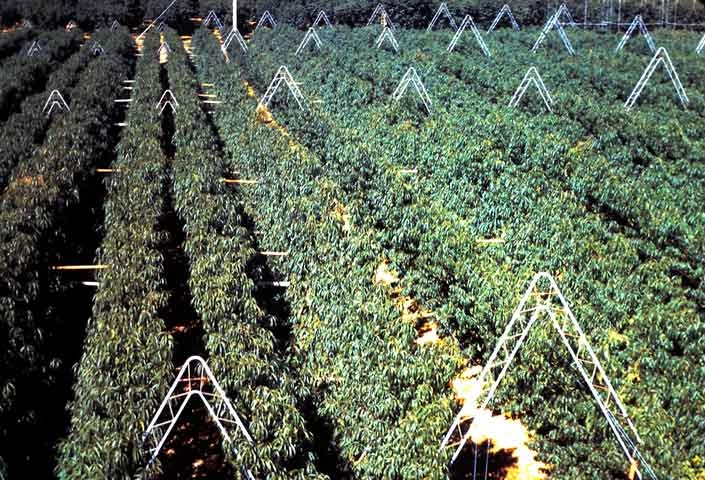Solution found in systems research: Close planting, tree arrangement, a support structure and an emphasis on tree training, provided those solutions.
(Continued from last issue)
A high-density orchard is an intensive orchard. A fruit tree has a bearing portion (foliage and fruiting buds) and a support portion (trunk and branches).
In a high-density orchard, more of the space is devoted to bearing and less to support. Therefore we needed to develop a new research method at the Station.
It was critical that we added a strategic focus to research activities. Sure, we needed more research, but we also needed better research. That premise underlies the approach of a new way of doing research, called systems research.
The only way of decreasing costs in Australia was through technical development. So the Tatura Horticultural Research Station aimed to develop technical efficiency in several ways to increase productivity of GV and MV orchards.
Research inside and outside the fruit tree
We needed to understand in detail the:
•tree’s physiology of growth and production
•tree’s reaction to the environment
•light interception and light distribution throughout the canopy
•hormonal control of fruit set and development
•water stress
•inorganic nutrition
•partitioning of photosynthates
•analyses of tree growth and root activity.
We integrated all of these into a whole-tree model.
We needed to systematically examine the factors that made up yield. We wanted to know how to:
•load up the tree with the correct number of fruit (fruit-set)
•fill those fruit to the desired size
•repeat these steps year after year.
For example photosynthesis—the process of converting light energy and atmospheric carbon dioxide into chemical energy to produce photosynthates and oxygen—is the most obvious factor limiting productivity of any fruit crop.
Most of the dry matter of a fruit tree is due to photosynthates.
Nutrients from fertilisers make up only 5–10% of the dry matter of a fruit tree. Most of the remaining 90–95% is made of photosynthates (cellulose, hemi-cellulose, starch, sugars, chlorophylls, and anthocyanins).
Yet, while we generally understood photosynthesis, we knew nothing of how this applied to a fruit tree.
The environment and physiology that affected photosynthesis would need deeper or more basic research.
Physiological effects (e.g. hormonal changes) and environmental effects (e.g. light micro-climate and its effect on photosynthesis), could only be studied at the level of photosynthesis itself.
If we were to identify further bottlenecks of carbohydrate production we needed to understand the total production of dry matter and the subsequent loss of part of this by the tree.
A balance between the inputs and outputs of a tree determines its productivity.
In our research we considered the tree as a factory and we intended to measure the tree’s inputs against its outputs.
Our balance sheet would tell us how the photosynthates were distributed around the tree, and what proportion finally determined the yield of fruit.
This in turn gave us a measure of the efficiency of the tree from a practical point of view. All of this contributed to our understanding of photosynthesis, water relations and light penetration.
Since we continually followed this balance–sheet throughout the growing season, we discovered how seasonal and physiological changes affected the balance sheet. We understood how we could modify, or better use, the trees’ photosynthesis for crop production.
Water status in the tree
Rates of replenishment and loss of water interact to produce the water status in the fruit tree. The maintenance of favourable water status and open stomata of the leaf were essential to high rates of photosynthesis and thereby high yields.
Soil structure
Soft stable porous soil was considered very important for high yields in a high-density irrigated orchard.
In contrast to soils for fruit production in Europe and North America, soils in north-central Victoria are old and highly weathered.
The irrigated surface soils set hard when dry and the subsoils are massive clays with low permeability and drainage, and restrict roots.
The research was directed towards creating and maintaining an environment that did not restrict roots.
(cont next issue)
See this article in Tree Fruit June 2019






















